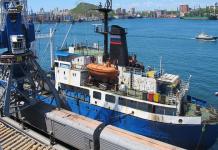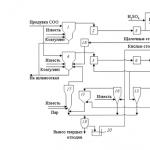The Code sets out basic principles, detailed recommendations for individual substances, materials and articles, and a range of recommendations for good operational practice, including advice on terminology, packaging, labelling, storage, segregation and handling and emergency procedures.
International Maritime Dangerous Goods Code - IMDG
MMOG— serves the purposes of ensuring the safe transportation of dangerous goods by sea, protecting ship crews and preventing pollution of the marine environment. The main provisions of the code are based on UN recommendations on the transport of dangerous goods. At the same time, the code contains such important provisions regarding the specifics of the maritime transportation of dangerous goods, such as the placement and separation of dangerous goods on board ships, actions in emergency situations, transportation of sea pollutants and other issues related to ensuring transport safety at sea in general.
Transportation of dangerous goods
The latest current edition of 2010, which includes amendments 35-10, is valid until 2013 and consists of two volumes and an addendum.
Volume 1
Part 1. General provisions, definitions and personnel training:
- General provisions;
- Definitions, units of measurement and abbreviations;
- Personnel training;
- Safety Regulations;
- General provisions regarding dangerous goods of class 7.
Part 2. Classification:
- Introduction;
- Grades 1-9;
- Sea pollutants.
- Explosives and products;
- Gases;
- Flammable liquids;
- Flammable solids, substances capable of spontaneous combustion;
- Substances that emit flammable gases when interacting with water;
- Oxidizing agents and organic peroxides;
- Toxic and infectious substances;
- Radioactive materials;
- Corrosive substances;
- Other hazardous substances and products.
Part 3. List of hazardous substances, special provisions and exceptions, see Volume 2.
Part 4. Packaging and tank provisions:
- Use of packaging, including intermediate bulk containers (IBCs) and large packaging;
- Use of portable tanks and multiple element gas containers (MEGCs);
- Use of containers for bulk cargo.
Part 5. Departure Procedures:
- General provisions;
- Markings and danger signs of cargo units, including (IBCs);
- Hazard labels and markings of cargo transport units;
- Documentation;
- Special provisions.
Part 6: Design and testing of packagings, intermediate bulk containers (IBCs), large packagings, demountable tanks, multiple element gas containers (MEGCs) and road tankers:
- Regulations on the design and testing of containers;
- Regulations on the design and testing of pressure vessels, aerosol dispensers and small containers containing gas (gas cartridges) and fuel sectional cartridges containing liquefied flammable gas;
- Regulations on the design and testing of containers for infectious substances of category A;
- Regulations for the design, testing and approval of Class 7 packages and materials;
- Regulations on the design and testing of intermediate bulk containers (IBCs);
- Regulations on the design and testing of large containers;
- Regulations on the design, construction, inspection and testing of portable tanks and multiple element gas containers (MEGCs);
- Tank Vehicle Regulations;
- Provisions for the design, construction, inspection and testing of bulk containers.
Part 7. Provisions concerning transport operations:
- Placement of dangerous goods;
- Separation of dangerous goods;
- Special provisions for accidents and fire safety related to dangerous goods;
- Transportation of cargo transport units on ships;
- Transportation of dangerous goods in lighters on lighter carriers;
- Temperature control provisions;
- Transportation of waste;
- Exceptions, approvals and certifications.
Volume 2
Part 3. List of dangerous goods, special provisions and exceptions:
- General provisions;
- List of dangerous goods;
- Special provisions applicable to certain substances, materials and articles;
- Limited quantities;
- Packaging of dangerous goods in exceptional quantities.
International Code for Safe Operations Management - ISM Code
International Safety Management Code - means the international code for the management of the safe operation of ships and the prevention of pollution.
 Ship Safety Management
Ship Safety Management The objectives of the international safety management code are to ensure maritime safety, prevent accidents or loss of life and avoid damage to the environment, particularly the marine environment and property.
International Code for the Construction and Equipment of Ships Carrying Dangerous Chemicals in Bulk - IBC
IBC Code- provides an international standard for the safe carriage by sea of hazardous and noxious liquid chemicals in bulk, to minimize risks to ships, their crews and the environment, the code provides for the design and construction to standards of ships and the equipment they carry, taking into account the properties of the goods carried .
 Safe transportation of chemical cargo
Safe transportation of chemical cargo The purpose of the code is to establish an international standard for the safe maritime transport in bulk of dangerous chemicals and noxious liquid substances listed in the code. The Code prescribes standards for the design and construction of ships, regardless of tonnage, used for such transport, as well as the equipment that they must have, in order, taking into account the properties of the products carried, to reduce to a minimum the danger to the ship, its crew and the environment.
International Code for the Construction and Equipment of Ships Carrying Liquefied Gases in Bulk - IGC
This code was developed to provide an international standard for the safe maritime carriage of bulk, liquefied gases and certain other substances. The Code specifies the design and construction features of such vessels and the equipment they must have.
 Equipment for ships transporting liquefied gases in bulk
Equipment for ships transporting liquefied gases in bulk The purpose of the code is to provide an international standard for the safe transportation by sea, loading of liquefied gases and certain other substances, specifying the design and construction according to the standards of ships involved in such transportation. The availability of equipment is necessary to minimize the risk to the ship, its crew and the environment, taking into account the properties of the cargo being transported.
International Convention for Safe Containers Code - CSC
The Safe Container Convention has two objectives:
- First— maintaining a high level of safety of human life in transport and during container handling, providing generally acceptable test procedures and corresponding strength requirements;
- Second— is to facilitate the international transport of containers by ensuring uniform international safety regulations that are equally applicable to all types of land transport. In this way, the proliferation of different national safety regulations can be avoided.
The requirements of the convention apply to most freight containers used internationally, with the exception of those designed specifically for transport by air.
 Secure cargo containers
Secure cargo containers The convention limits the minimum size of containers and requires corner fittings - devices that allow containers to be secured or stacked.
Technical Applications
The Convention includes two annexes:
- Appendix I - includes rules for testing, inspection, and maintenance of containers;
- Appendix II - Includes structural safety and test requirements, including details of test procedures.
International Code for the Safe Transport of Solid Bulk Cargoes - IMSB
Provides guidance to bulk carrier owners and masters, charterers, terminal operators and other interested parties for the safe movement, loading and unloading of solid bulk cargoes. The recommendations contained in the code may comply with terminal and port requirements or national standards.
It primarily covers the safety of vessels loading and unloading solid bulk cargoes other than grain and reflects current issues, best practices and legal requirements. Broader safety and pollution prevention requirements, issues such as those covered by SOLAS, MARPOL and the Load Line Convention, were not previously specifically included in the code.
International Code for the Safe Transport of Spent Nuclear Fuel, Plutonium and High-Level Radioactive Waste in Packages on Ships - SNF Code
The Code establishes the specification of materials and compliance of ships for the transport of radioactive cargo.
The list of materials specified in the code includes:
- Irradiated nuclear fuel is material containing uranium, thorium and plutonium isotopes that was used to support a self-sustaining nuclear chain reaction;
- Plutonium is the resulting mixture of isotopes resulting from the extraction and reprocessing of irradiated nuclear fuel;
- High levels of radioactive liquid waste generated during the mining and processing of radioactive materials.
Specific provisions in the code cover a number of issues, including:
- Damage to stability;
- Fire protection;
- Temperature control of cargo spaces;
- Structural changes;
- Cargo securing devices;
- Electrical equipment;
- Radiological protection of equipment and management plans;
- Training the ship's crew to act in an emergency.
The Code establishes three categories of ships carrying spent nuclear fuel depending on the total activity of the cargo:
- Class INF 1 - ships for transporting cargo with a total activity of less than 4000 TBq (radioactivity measurement) or (4 x 1015Bq);
- Class INF 2 - ships for transporting irradiated nuclear fuel or high-level radioactive waste with a total activity of less than 2 l6TBq, (2 x 1018Bq) and ships that are certified for transporting plutonium with a total activity of less than 2 x 105TBq (2 x 1017Bq );
- Class INF 3 - ships for transporting irradiated nuclear fuel or high-level radioactive waste, plutonium, without limiting the maximum total reactivity of the materials.
SNF Code— obliges the shipowner to obtain an international certificate of conformity of the vessel for the carriage of dangerous goods and subsequently carry out surveys in accordance with SOLAS.
46 and 49 C.F.R. - US Code of Federal Regulations
46 C.F.R.— contains rules on the transportation of dangerous goods in bulk, compatibility of cargoes (Compatibility of Cargoes). A list of incompatible goods and rules for handling them are presented. The main document on cargo compatibility, the “Compatibility chart”, is presented in the form of a table with the names of cargo arranged so that when compared, the required answer is obtained on the compatibility of different dangerous and other cargo intended for loading.
Subsection C— hazardous materials, “Training requirements” provisions — contains a description of the training requirements for HAZMAT (Hazardous Materials) personnel, that is, all participants in the transportation of dangerous goods, methods of prevention and safe service for all logistics of moving dangerous goods. Frequency of training and theoretical training, maintaining the necessary records and reports on the status and possible circumstances.
49 C.F.R.- has the title “Transportation of dangerous goods”, refers only to the transportation of packaged goods and does not apply to goods transported in bulk or liquid.
It provides special requirements for command and rating personnel responsible for cargo operations on ships transporting packaged hazardous substances.
The training of personnel responsible for carrying out cargo operations when transporting dangerous goods should consist of three parts:
- General part - concepts, definitions, basic requirements for the handling and storage of dangerous goods on board a ship;
- Application of basic principles of dangerous goods handling to ship operation;
- Ensuring safety - understanding the harmfulness of a particular substance, using protective equipment, acting in emergency situations related to the transportation of dangerous goods.
Although all international requirements require that adequate dangerous goods handling training be provided every 5 years, the US Coast Guard requires that such training be provided at intervals of at least every two years. All requirements for the preparation of shipping documents required for the transport of dangerous goods are specified in subsection “C”. When filling out documents, a certain sequence and requirements must be observed.
Firstly, if a hazardous material intended for transportation is not included in the list of these rules, then its description must be included in the cargo documents in a color distinguishable from the text of the document, highlighted with a marker, or the letters “X” or “RQ” must be located before the name of the material. The description of the material should not contain codes and abbreviations not provided for by these rules.
Secondly, the material description may contain additional information about the cargo if the information does not contradict the required description rules.
Third, if the cargo documents contain more than one page, then the first page must indicate the total number of pages, and each subsequent page must be marked so as to indicate the page number out of the total number of pages.
Fourth, the documents must indicate emergency telephone numbers in the event of an incident with cargo, as defined in subsection “C” of these rules.
 Marking on dangerous goods
Marking on dangerous goods Each package must contain the markings prescribed by these rules and an identification number. Moreover, if the package contains more than 1,000 gallons of hazardous material, then the label must be placed on each side and each end of the package. If the package contains less than 1,000 gallons of hazardous material, the label must be placed on two opposite sides of the package. The marking must be reliable, made in black or a color contrasting with the packaging, the inscriptions must be in English, the marking must be located separately from all other types of marking.
The main difference between the C.F.R. from IMDG labeling requirements in that C.F.R. provide for special marking of dangerous goods for domestic transport. In addition to the UN number, the marking must also include the TECHNICAL NAME of the cargo, as well as the sender’s address. Next, clear instructions are given regarding the size of the inscriptions, their location on containers and transport units, special symbols and designations that are used when marking each hazard class. In accordance with the requirements of these rules, all dangerous goods are divided into classes.
First aid rules for incidents involving dangerous goods - MFAG
The Medical First Aid Guide for Dangerous Goods (MFAG) is an annex to the international medical guidelines for ships. The guidance given in this manual applies to substances, materials and articles that are included in the International Marine Dangerous Goods Code and materials included in Annex B of the Bulk Cargo Safety Code. This guidance should be used in conjunction with information obtained from the IMDG. It is intended to provide guidance necessary in the diagnosis and treatment of chemical poisoning to the extent available on board the ship. Information on the treatment of diseases of a general nature and not related to chemical poisoning can be found in IMGS.
Minor injuries, including chemical injuries, usually do not cause serious consequences if the appropriate first aid measures described in this manual are taken. Although the number of known serious accidents is small, those involving chemicals that are toxic or corrosive can be dangerous and should be treated as potentially serious until each individual has fully recovered or medical advice has been obtained. Any person affected by chemical poisoning should be examined by a doctor at the next port of call.
In the Guide, chemicals are grouped into tables according to their chemical properties.
There may be varying degrees of toxicity within a group. Where a chemical substance, chemical solution or mixture is classified as N.O.S., that is, not specifically listed in the IMDG code, it is included in a table that consists of the medical toxicities expected from poisoning with that substance. For such goods, a number different from those specified in the IMDG code may be declared if such a number is more appropriate. Sometimes it is not possible to assemble a table at all due to the wide variety of possible medical consequences and for these situations general guidance on appropriate treatment is given.
The tables themselves provide general information about a particular group of chemicals and indicate possible toxic effects. Treatments recommended in this guideline are discussed either in the appropriate section or in the appropriate table. However, there are differences between countries on certain types of treatment, and when these differences exist, they differ in the relevant national medical guidelines.
In these circumstances, when it is suspected, but not definitely certain, that the patient is suffering from chemical poisoning, you should familiarize yourself with the necessary information in the “Diagnoses of Poisoning” section of this manual.
Suggested reading:
Sea transportation occupies a fairly large niche among all types of cargo transportation. Various types of goods and products are delivered by ships. Sea transportation is also intended for the transportation of dangerous goods.
Dear readers! The article talks about typical ways to resolve legal issues, but each case is individual. If you want to know how solve exactly your problem- contact a consultant:
APPLICATIONS AND CALLS ARE ACCEPTED 24/7 and 7 days a week.
It's fast and FOR FREE!
What rules have been developed to ensure the maximum level of safety in water transport? Read on to find out what requirements international agreements impose on a transport company, a sea vessel and its crew.
When and by whom it was introduced
The International Maritime Organization (abbreviated IMO) began developing a Code of Practice for the Transport of Dangerous Goods in the mid-1960s.
This document was considered an annex to the existing and successfully operating Convention for the Safety of Life at Sea.
The final version of the Code was adopted on September 27, 1965. The document was signed by representatives of more than 68 countries. At first, the document was purely advisory in nature and was not obligatory for exact execution.
In 2002, the document was edited. To a greater extent, the amendments affected the transportation by sea of goods classified as dangerous.
At the same time, it was decided to introduce the obligation of punctual execution of all clauses of the Code from January 1, 2004.
The main purpose of the Code is to ensure maximum safety:
- water spaces in order to preserve the flora and fauna of reservoirs that are national property;
- crews of sea vessels directly performing transportation;
- port employees loading and unloading ships.
The provisions of the document apply to all ships transporting hazardous substances, regardless of their type and size.
Types of hazards during transportation
When transporting goods by sea, you may encounter:
- with force majeure circumstances, which include: tsunami, storm, unmarked shoals, and so on. These types of hazards do not depend on the crew members and cannot be foreseen in advance. Therefore, any crew must be able to cope with critical situations;
- if the crew operating the vessel is not sufficiently prepared, there is a possibility of straying from the previously planned course. Due to an error, goods that have certain conditions for transportation may be damaged;
- with emergency circumstances caused by improper packaging or labeling of hazardous substances;
The ship's crew must not only be able to act harmoniously and quickly, but also be educated enough to find out in the shortest possible time what means can be used to prevent pollution of the sea and the environment.
- with long transportation times, problems may arise with the conditions for transporting dangerous goods;
- the possibility of military operations unfolding along the route, the ship being captured by pirates, and so on, cannot be ruled out. Such situations also refer to unforeseen circumstances.
Requirements
The International Code also imposes certain requirements for:
- transport companies organizing the transportation of hazardous substances and materials;
- ship's crew;
- directly to the vehicle itself;
- containers and packaging, as well as labeling of transported substances.
To companies
A transport company engaged in organizing the transportation of dangerous goods by sea must have a permit - a license to engage in such activities.
To obtain permission you need:
- prepare loading points for dangerous goods in accordance with all requirements;
- equip ships with safety equipment;
- prepare personnel who will perform loading (unloading) of hazardous substances.
The company is obliged to constantly monitor:
- good condition of port equipment;
- serviceability of vessels making voyages;
- personnel qualifications.
The responsibilities of responsible persons also include conducting periodic safety training when working with hazardous substances.
To personnel on ships and in port
Company employees who are officials and are responsible for preparing transportation are required to know:
- existing rules for transporting hazardous substances;
- safety rules when carrying out loading and unloading operations;
- list of documents required to accompany cargo;
- types of hazards and methods for eliminating them when working with certain types of dangerous goods;
- methods of packaging goods that ensure maximum safety along the route of a sea vessel;
- signs marking hazardous materials;
- methods of placing and securing containers on board the ship;
- ways to prevent critical situations;
- rules for providing first aid in emergency situations.
Responsible employees are required to complete a training course, pass qualification exams and receive appropriate certificates.
The ship's crew, including the captain and the person in charge of safety, must know:
- general rules for transporting substances harmful to the environment and human health;
- a list of cargo on board the vessel and ways to eliminate the existing danger;
- conditions of transportation of certain types of substances;
- methods for eliminating the consequences of emergency situations;
- safety precautions in case of critical situations;
- methods of providing first aid.
It is intended both for officials responsible for preparing delivery and transportation itself, and for companies whose employees are the responsible persons.
To floating facilities
A vessel intended to transport hazardous substances is required to undergo a pre-voyage inspection and obtain permission to carry out transportation. A record of the vessel's approval is made in the Register certificate.
To pass a technical inspection, a floating vehicle must be equipped with:
- an independent ventilation system in the cargo compartment, eliminating the possibility of ignition of transported goods;
- fire alarm and automatic water fire system;
- if it is necessary to maintain a certain temperature regime during the delivery of goods, special containers are required that are attached to the side of the vessel;
- all electrical equipment of the ship must be protected by a fire-proof and explosion-proof enclosure;
- premises for the transportation of dangerous goods should be located at the maximum possible distance from the cabins belonging to the ship's service personnel;
- all pipes removing combustion products from engines and other devices must be equipped with spark arresters and spark arresters;
- cargo compartments are equipped with temperature and humidity sensors.
Vessels must additionally be equipped with:
- portable fire extinguishers;
- breathing apparatus;
- complete sets of clothing for chemical protection.
In addition to the basic requirements, there are additional ones. Before each flight the following must be carried out:
- cleaning and wet cleaning of premises intended for the transportation of goods;
- checking the technical condition of all the main components of the ship and safe life support systems.
To containers and packaging
Separate requirements apply to containers in which hazardous substances are transported, packaging and labeling.
Packaging used for the transportation of dangerous goods must be:
- made with high quality and in satisfactory condition;
- made from materials inert to substances;
- capable of protecting goods in the event of a critical situation.
The following types of packaging are distinguished depending on the type of substance transported:
- hermetic packaging is used to transport substances in a gaseous state;
- Effectively sealed or moisture-proof packaging is used to transport liquids;
- securely closed packaging for transporting bulk substances.
If substances are transported in small packages, they must be loaded into another, larger container.
Please note that not all substances can be transported together in one package. The placement of goods on the ship is carried out by a responsible person under the supervision of the ship's captain.
All individual packages and containers must be marked with danger signs. The sign corresponding to the cargo being transported must be affixed to both small and large containers, and the sign is always duplicated.
reflect:
- a visual symbol of a possible problem, for example, if a substance is susceptible to spontaneous combustion, then a fire is depicted;
- letter designation of the image;
- hazard class number corresponding to the substance being transported.
In some cases, signs may also display other information, for example, when transporting radioactive substances, it is recommended to indicate the exact name of the substance and the level of contamination.
If several different types of hazardous substances are transported in a container, then all danger signs are glued to the surface of the container.
Information about the signs is also reflected in emergency cards kept by the responsible person. Each emergency card contains a code consisting of numbers and letters that should be used in the event of a critical situation.
Liability for violations of the International Maritime Dangerous Goods Code
For failure to comply with the requirements for the carriage of dangerous goods by sea, liability may be assigned to:
- to a transport company organizing transportation;
- to the person responsible for loading and labeling;
- to the commander of the ship's crew;
- to the responsible person accompanying the cargo to its destination.
The company and its employees are responsible for:
- incorrect labeling of substances;
- improper loading of substances;
- loading of substances not reflected in the accompanying documents.
Persons accompanying the cargo, including the captain of the ship's crew, are responsible for:
- compliance with the conditions of transportation of substances;
- the correctness of taking measures required by the rules in the event of emergency circumstances.
Responsibility may be:
- administrative, that is, in the form of penalties. Administrative liability is applied exclusively in case of non-compliance with minor conditions that do not result in environmental consequences;
- criminal In case of irreparable consequences to the world's resources.
Possible consequences of non-compliance with the rules
The main consequences of incorrect transportation of dangerous goods by sea vessels can be:
- sea pollution. Violation of the general environmental situation both in a separate region and in neighboring areas;
- destruction of sea flora and fauna.
The consequences may affect not only environmental safety, but also the ship itself, as well as its crew. Improper transportation of hazardous substances can lead to a fire and the complete destruction of the ship and its crew.
Failure to comply with the conditions regarding working with hazardous substances can cause serious illness, injury and, as a result, disability.
The deterioration of the environmental situation can also affect the people around us, also causing severe forms of various diseases and injuries. In this regard, it is necessary to approach toxic and radioactive substances with extreme caution.
With regard to the transport of dangerous goods by sea, the Russian Federation has adopted rules at the national and international levels. Participants in foreign trade activities involved in foreign trade in raw materials and goods of this class need to know the methodological recommendations for their transportation.
First, let's figure out what substances and materials fall under this category and what their classification is, and then we'll get acquainted with the basic rules of sea transportation in accordance with the IDR Code. Let's touch on the rules of packaging, labeling and accompanying documents necessary for the transportation of dangerous goods.
What is dangerous goods?
Dangerous goods are any objects whose characteristics and properties can:
- threaten human life and health;
- cause irreparable harm to the environment;
- lead to damage to material objects.
The following substances fall under this designation:
- that may explode due to friction or detonation, leaving widespread destruction;
- that can easily ignite under the influence of temperature or other factors;
- causing a corrosive process in ordinary storage containers, which may lead to the release of the substance;
- belonging to the category of strong poisons dangerous to human life and health.
MK RID is the main document regulating the transport of dangerous goods by sea.
Classification
According to GOST, classes of dangerous goods are distinguished:
- substances capable of causing an explosion;
- compressed gas substances dissolved under pressure;
- liquids that are easily and quickly flammable;
- solids that are easily ignited; spontaneously combustible substances; cargoes that, when exposed to water, emit gases that are susceptible to ignition;
- oxidizing cargoes; organic peroxides;
- poisonous cargo, as well as cargo that can cause infection;
- radioactive cargo;
- caustic substances, as well as substances that can cause corrosion;
- other cargo dangerous to humans and the environment.
There are selected based on their characteristics and degree of danger.
The captain is responsible for the readiness of the vessel to transport dangerous cargo.
Transportation rules
 The International Maritime Dangerous Goods Code (IMDG) was developed by the International Maritime Organization (IMO). The Code is often edited and supplemented. Includes 4 parts, based on them we can highlight the key rules of transportation according to the MK RID.
The International Maritime Dangerous Goods Code (IMDG) was developed by the International Maritime Organization (IMO). The Code is often edited and supplemented. Includes 4 parts, based on them we can highlight the key rules of transportation according to the MK RID.
- Dangerous goods must be stowed and secured so that safety standards are not violated. The method of securing the load depends on its properties and hazard class.
- Explosive class cargo, are placed in special rooms. Premises must be locked during transport. There should be no detonators near such cargo.
- Cargoes belonging to the class of substances that emit dangerous vapors, are placed in a special room where ventilation is provided.
- For cargo belonging to the class of liquids or gases susceptible to ignition, special measures must be taken to prevent fire.
- On a vessel through which export or import transportation is carried out, there must be a set of MKDOG.
- Import or export transportation of dangerous goods cannot be carried out without compliance with the IDR Code., however, in the event of force majeure, actions not included in the code are possible, aimed at saving people and cargo.
- When transporting goods that require special temperature and humidity conditions, the carrier will be required to provide a Cargo Performance Certificate.
- The ship must have special cargo space, fire extinguishing agent appropriate for this type of cargo.
- In the event that incompatible goods are transported, the vessel must have appropriate accommodation conditions.
In addition to the RID Code, maritime transport of dangerous goods is regulated by the international convention MARPOL 73/78 (prevention of pollution of ships) and SOLAS 74 (an international convention aimed at the protection of life at sea).
When transporting cargo of foreign charterers, packaging, labeling, documentation, and cargo class must comply with the IDR Code.
Packaging requirements
 In accordance with GOST (26319-84) and the rules for the transportation of dangerous goods, the shipper is obliged to pack the cargo in such a way that the packaging minimizes possible risks during transportation and loading and unloading. The packaging must meet a number of characteristics.
In accordance with GOST (26319-84) and the rules for the transportation of dangerous goods, the shipper is obliged to pack the cargo in such a way that the packaging minimizes possible risks during transportation and loading and unloading. The packaging must meet a number of characteristics.
- High quality, good performance characteristics.
- Presence of internal surface, which will not provoke the risk of force majeure when cargo comes into contact with it.
- Performance properties that will allow you to withstand the risk of loading and unloading and sea transportation.
The cushioning material required when transporting hazardous liquids also has a number of requirements. He must:
- prevent dangerous effects that the load may have;
- prevent the movement of the vessel with liquid, fit tightly to it;
- if possible, the volume of material should be such that it is enough to absorb liquid if the container is damaged;
- in containers for hazardous liquids, at a temperature appropriate to the liquid when filling, there must be free space. The amount of free space depends on the maximum operating temperature during transport;
- If there is an uncleaned empty container on board that previously contained a hazardous liquid, the above rules also apply to it. The exception is for containers for which actions have been taken to make them safe.
Marking
Special signs indicate that there is dangerous cargo on board the ship. Labeling requirements are regulated by GOST (19433-88) and the rules of RID.
When transporting dangerous goods by sea, the packaging and container in which the cargo is located are marked. Special labels are installed both on the cargo itself and on the vehicle transporting it.
Labeling of dangerous goods must meet the following requirements:
- availability of indication of the correct technical name of the cargo. Specifying only a commercial name is against the rules;
- danger signs corresponding to the class of cargo, clearly indicating its dangerous characteristics;
- Regardless of the method of marking, it should not be erased when exposed to sea water for at least three months. When choosing a marking method, the reliability of the means used and the characteristics of the packaging surface should be taken into account;
- Each package must be marked with danger signs and markings. The only exceptions are goods with a reduced degree of danger and goods transported in small quantities. Exceptions also apply to special circumstances when it is permissible to place goods on packages that have appropriate hazard labels.
Accompanying documents
 The rules also apply to accompanying documentation when transporting dangerous goods.
The rules also apply to accompanying documentation when transporting dangerous goods.
- A ship carrying dangerous cargo must have an inventory, manifest or cargo plan, which indicates the technical name, characteristics, hazard class of the cargo, as well as its location. Copies of this document must be presented to port officials for departure of the vehicle.
- Documents related to the transported cargo are accompanied by a signed certificate certifying that the dangerous cargo is properly packaged, labeled, labeled, and can be transported. The document must be presented by the person responsible for packaging.
- If there is reasonable doubt about the fact that a cargo transport unit (CTU) does not comply with the above container rules, then it should not be accepted for shipment. A similar rule applies in the absence of a certificate of correct placement in a container/vehicle.
- If there are any violations of the packaging (the container is deformed, damaged, leaves marks, stains), the dangerous cargo is not loaded onto the ship.
- Cargo transport units are placed and secured based on the Cargo Securing Manual, which has received the approval of the Administration.
Shippers often charter ships to transport dangerous goods. Information on how freight is calculated


















